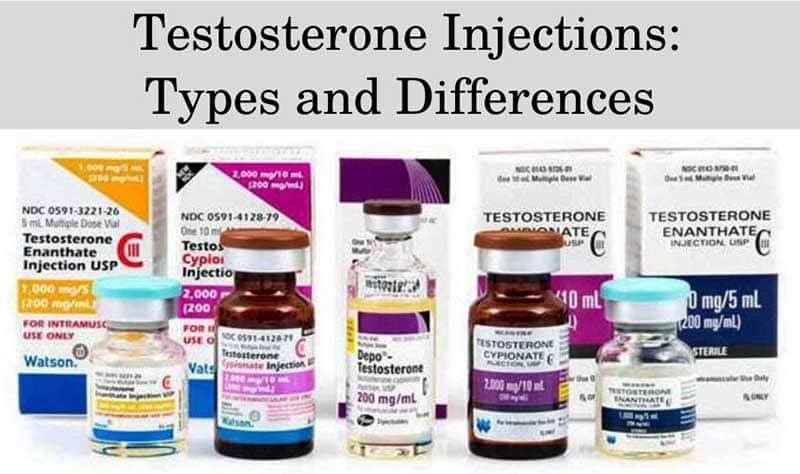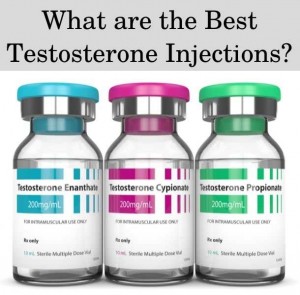In this article
Testosterone replacement therapy (TRT) is currently the most effective treatment for managing the symptoms of low T in men. Testosterone is also the drug of choice for masculinizing hormone therapy in female-to-male (FTM) transgender patients.
TRT is available in many forms, but testosterone injections stand out as the widely preferred method by patients and clinicians alike.
Due to the risk of abusing testosterone medications, you can purchase genuine and legal TRT only after obtaining a prescription from your medical doctor. Your doctor will also decide which is the best form of TRT for you.
Currently, the FDA has approved 4 types of injectable testosterone: cypionate, undecanoate, propionate, and enanthate.
They differ mainly in regard to their half-life and the fluctuations they can cause in your T levels. Depending on the dosing regime, they have similar effectiveness and risk for adverse reactions.
4 Best Types of Injectable Testosterone
Testosterone injections are the preferred form of TRT for most patients and medical doctors. They are also the best choice for new patients because this form of TRT can be dosed more precisely, making it easier to find the optimal dose for each individual.
Apart from injections, TRT is also available as implants (pellets), nasal and transdermal gels, oral and skin patches, and oral pills.
Most patients prefer injections due to their affordability and quick results. Injectable testosterone can help manage the symptoms of hypogonadism faster compared to other forms of TRT.
73% of patients prefer injections because of the lower cost and doctor’s recommendation
The injections contain testosterone in the form of fat-soluble compounds called esters. Esterification significantly increases the medication’s half-life, compared to unmodified T, which has a half-life of 10 – 100 minutes.
The testosterone esters used for TRT include:
- Testosterone Cypionate
- Testosterone Undecanoate
- Testosterone Enanthate
- Testosterone Propionate
They are all available in oil solutions. Historically, propionate and unmodified testosterone have also been available as an aqueous suspension. They are no longer used due to the short half-life (from several minutes to several hours) and the higher risk for adverse reactions.
Testosterone cypionate is available under the brand name Depo-Testosterone (manufactured by Pharmacia & Upjohn Company LLC, Pfizer, Inc., US) or also as a generic medication. It must be injected intramuscularly (IM) every 2-4 weeks.
Testosterone undecanoate is available under the brand name Aveed (manufactured by Endo Pharmaceuticals, Inc., Ireland) or also as a generic medication. It is available in doses of 750 mg, which must be injected IM once every 10-12 weeks. That’s because the half-life of the medication is 34 days. Yet the second dose of undecanoate is usually administered as soon as 4 weeks after 1st dose in order to initiate a faster increase of T levels to physiological ranges.
Testosterone enanthate is available as an autoinjector device under the brand name Xyosted (manufactured by Antares Pharma, Inc., US). It must be injected every week subcutaneously (SC). In addition, enanthate is available as a generic medication for IM injections which must be applied every 1 to 4 weeks.
Testosterone propionate is no longer available commercially in the US due to its short half-life. Yet, generic forms are still produced by compounding pharmacies. Patients must apply it via IM injections every 1-3 days.
Which type of testosterone treatment is the best?
TRT can help patients with low T due to primary and secondary hypogonadism, gender reassignment, and hypoactive sexual disorder.
All FDA-approved injectable testosterone esters have comparable safety and effectiveness in men with hypogonadism. Studies do not report any differences in the changes of biological parameters or the rate of adverse reactions between different esters. Furthermore, research suggests that it takes about 3-4 weeks of TRT for the first benefits to occur regardless of the exact type of injections.
There are no contraindications against switching from one form of testosterone to another during TRT. In fact, physicians often replace one form of TRT with another if the patient does not tolerate the first medication well. However, different testosterone esters cannot be used interchangeably due to their different half-lives.
The cheapest option
Cypionate is the most affordable type of testosterone for patients with hypogonadism is and the monthly cost of the therapy starts at around $50. Thus, it provides a more favorable quality-price ratio.
Despite the comparative effectiveness, forms with a shorter half-life such as propionate may lead to more fluctuations in serum T levels. For example, an animal study reported that undecanoate maintained stable serum T levels from day 1-45, while testosterone enanthate led to supraphysiological levels on day 1, which quickly declined after day 5.
Thus, your serum T levels during testosterone enanthate or propionate therapy may drop rapidly before the next dose and lead to symptoms of hormonal fluctuations such as fatigue or mood swings. It can be avoided by more frequent injections.
Best for FTM
Testosterone undecanoate appears to be the one most commonly used in patients who take T to align their bodies with their gender identity. The dose for masculinizing hormone therapy is 1000 mg every 12 weeks.
Nevertheless, guidelines report that all FDA-approved injectable testosterone esters can also be used for transgender patients.
The FDA has not approved TRT in women for any condition. Nevertheless, some physicians prescribe it off-label in postmenopausal women with specific indications such as hypoactive sexual disorder.
In such cases, your doctor will prescribe you a small physiological dose of transdermal testosterone.
Experts do not recommend injectable testosterone for female patients
Provides greater muscle and strength gains
In addition, testosterone esters are often abused by athletes and bodybuilders who aim to build more muscle, lose fat and boost their athletic performance. In such cases, they often use unregulated injectable forms with a shorter half-life, such as testosterone propionate or suspension, to quickly achieve supraphysiological serum T levels.
Bodybuilding circles profess testosterone suspension as a potent anabolic that can lead to a quick increase in muscle mass. It is an aqueous solution of unmodified testosterone and does not contain any esters.
Using large doses can lead to an immediate spike of serum T levels, followed by a quick decline, which is why testosterone suspension must be taken daily. Thus, T suspension is not as efficient as legal TRT which contains esters.
The rapid spike and the supraphysiological T levels increase the incidence of side effects so such “cycles” continue no longer than 6-16 weeks to reduce the risks of long-term steroid abuse.
Testosterone Cypionate vs Enanthate
Both enanthate and cypionate are efficacious, safe, and FDA-approved for therapy in men with low T. They are indicated for primary and secondary hypogonadism.
Furthermore, both forms get metabolized to testosterone in the liver. It can trigger the androgen receptors directly, get inactivated by binding to serum proteins, or get converted into dihydrotestosterone (DHT) and estrogen. DHT is an even more potent activator of the androgen receptors in the body. The activation of these receptors by T and DHT leads to the anabolic and androgenic effects of TRT.
The conversion of T into estrogen depends on the amount of body fat and the activity of an enzyme called aromatase that’s found primarily in adipose tissue. Both cypionate and enanthate can get aromatized to estrogen.
No toxicity has been found at therapeutic doses, but animal studies report that very high doses of testosterone enanthate and cypionate may lead to carcinogenesis. Both medications are eventually excreted through the urine.
Cypionate comes in 2 strengths – 100 mg/ml and 200 mg/ml in vials of 10ml. The main active ingredient is testosterone cypionate, while the inactive ones are cottonseed oil and benzyl alcohol (preservative). Cypionate has a longer half-life of 8 days, and thus it can maintain physiological serum T levels for more than 2 weeks. The recommended dose is 50-400 mg taken every 2-4 weeks. Cypionate can remain in your system for up to 6 weeks.
In comparison, enanthate is available in 1 ml vials. Each ml contains 250 mg of the active ingredient – testosterone enanthate. The inactive ingredients are sesame oil and chlorobutanol (preservative). Testosterone enanthate has a half-life of 4.5 days and maintains physiological serum T levels for up to 10 days. That’s why patients should take it every 1-4 weeks in 50-100 mg doses. Enanthate can remain in your system for up to 4 weeks.
On the other hand, research reports that it takes up to 48 hours for T levels to peak after testosterone enanthate injection, compared to 4-5 days after cypionate injection.
Testosterone Propionate vs Cypionate
Testosterone propionate and cypionate are both indicated for men with primary and secondary hypogonadism. Propionate is also extensively used in veterinary medicine to stimulate growth.
Propionate and cypionate have similar effectiveness, risks and toxicity. In addition, testosterone propionate can also increase water retention which leads to edemas.
Like cypionate, propionate is also metabolized in the liver to testosterone, which can trigger the androgen receptors directly, bind to inactivating proteins, get converted to the more potent DHT, or get aromatized to estrogen.
Propionate is excreted primarily through the urine, similar to cypionate. The medication comes in 10 ml vials. Every ml of the drug contains 100 mg of the active ingredient – testosterone propionate. Inactive ingredients include sesame oil and chlorobutanol (preservative).
Testosterone propionate has a considerably shorter half-life compared to other cypionate and other testosterone esters – just 20 hours. That’s why patients must apply it every 1-3 days.
The recommended dose varies from 30-50 mg a day. Propionate can remain in your system for up to 4 days.
Can you mix different types of testosterone for better results?
Mixing different types of testosterone esters is not something new. In fact, such combinations are also available commercially throughout the world.
For example, a testosterone propionate enanthate blend is available in Europe under the brand name Testoviron. In Mexico, there was a testosterone cypionate propionate blend available under the brand name Sten.
Compounding pharmacies can also mix enanthate and cypionate into testosterone cypionate enanthate blend.
The pharmacokinetics and pharmacodynamics of such blends depend mainly on the testosterone ester with a longer half-life. Thus, they do not provide additional benefits compared to T injections that contain a single testosterone ester.
Mixing injectable T with other forms of TRT is contraindicated as it makes it impossible to predict the dose. Maintaining supraphysiological doses increases the risk of side effects.
On the other hand, insufficient dosing can make your symptoms return. Therefore, it is best to consult with your doctor before changing your dosage or the form of your TRT.






